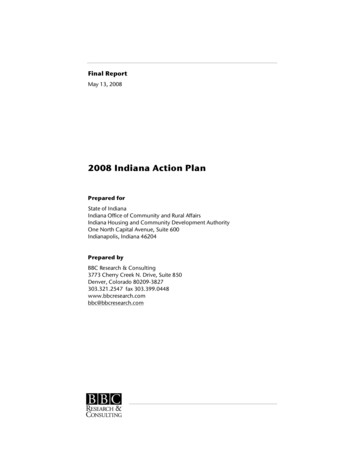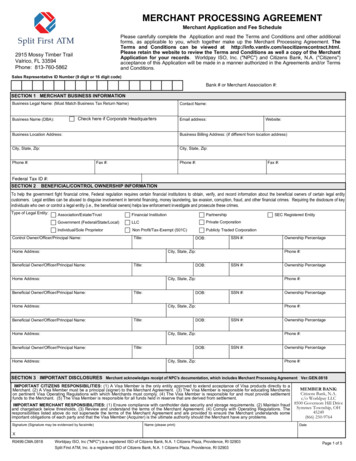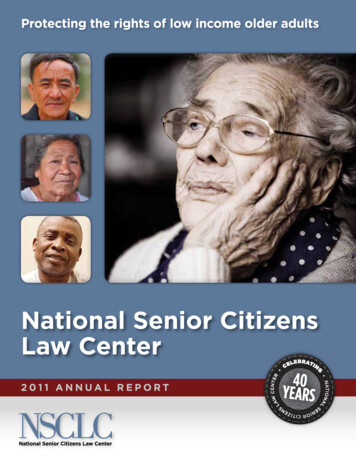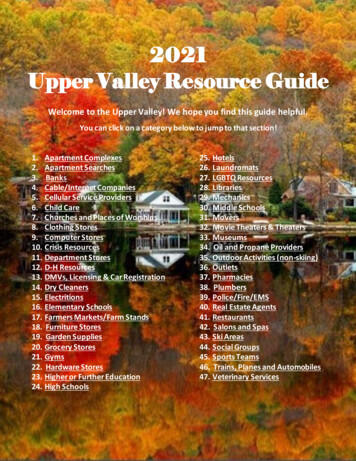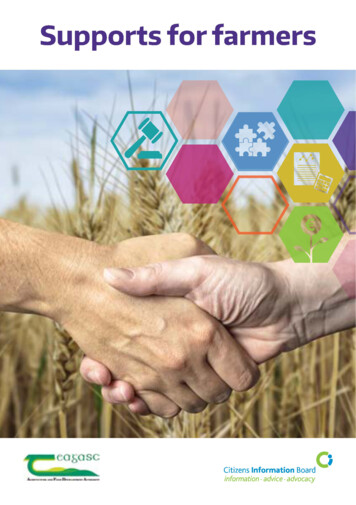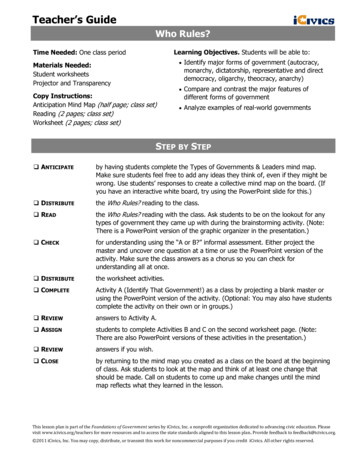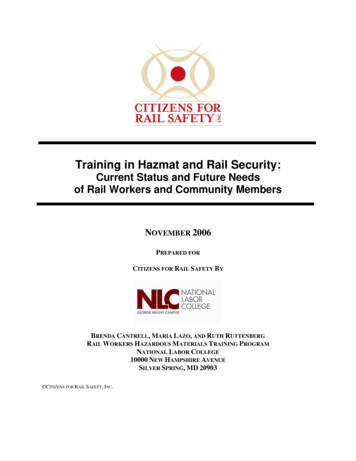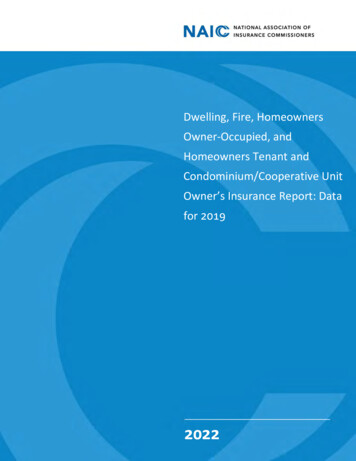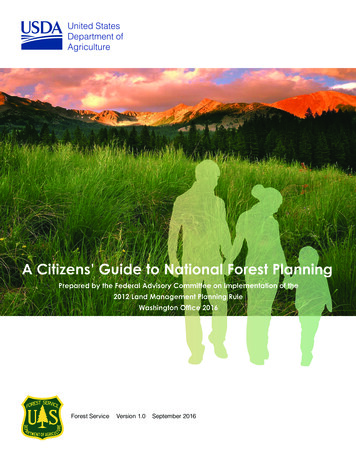
Transcription
United StatesDepartment ofAgricultureA Citizens’ Guide to National Forest PlanningPrepared by the Federal Advisory Committee on Implementation of the2012 Land Management Planning RuleWashington Office 2016Forest ServiceVersion 1.0September 2016
ForewordIn 2012, the Forest Service, an agency of the U.S. Department of Agriculture, adopted aninnovative new rule to guide land management planning in the National Forest System. The2012 Planning Rule is a significant advance in citizen-based land management planningintended to benefit communities, and to protect national important landscapes and resources.Because of the importance of sustainably managing the National Forest System with the helpof the public and other stakeholders, the Chief of the Forest Service and the U.S. Secretary ofAgriculture established a Federal advisory committee of citizens representing diverse intereststo help the Forest Service achieve a more collaborative approach to land management planning.While working with the Forest Service, the committee recognized that the new rule represents abig change in how the Forest Service conducts land management planning and felt strongly that acitizens’ guide was essential to help the public effectively navigate and get involved in the planningprocess. This is that guide. We hope you find it useful.Susan Jane Brown and Rodney Stokes, Committee Co-ChairsA Citizens’ Guide to National Forest Planning 3
In accordance with Federal civil rights law and U.S. Department of Agriculture (USDA) civil rights regulationsand policies, the USDA, its Agencies, offices, and employees, and institutions participating in or administeringUSDA programs are prohibited from discriminating based on race, color, national origin, religion, sex, genderidentity (including gender expression), sexual orientation, disability, age, marital status, family/parental status,income derived from a public assistance program, political beliefs, or reprisal or retaliation for prior civilrights activity, in any program or activity conducted or funded by USDA (not all bases apply to all programs).Remedies and complaint filing deadlines vary by program or incident.Persons with disabilities who require alternative means of communication for program information (e.g.,Braille, large print, audiotape, American Sign Language, etc.) should contact the responsible Agency orUSDA’s TARGET Center at (202) 720-2600 (voice and TTY) or contact USDA through the Federal RelayService at (800) 877-8339. Additionally, program information may be made available in languages other thanEnglish.To file a program discrimination complaint, complete the USDA Program Discrimination Complaint Form, AD3027, found online at http://www.ascr.usda.gov/complaint filing cust.html and at any USDA office or writea letter addressed to USDA and provide in the letter all of the information requested in the form. To requesta copy of the complaint form, call (866) 632-9992. Submit your completed form or letter to USDA by: (1)mail: U.S. Department of Agriculture, Office of the Assistant Secretary for Civil Rights, 1400 IndependenceAvenue, SW, Washington, D.C. 20250-9410; (2) fax: (202) 690-7442; or (3) email: program.intake@usda.gov.USDA is an equal opportunity provider, employer, and lender.The following photos are used with permission of the photographer:Pg 17 – Petrus Barcus (public meeting)Pg 59 – Lindsay Warness (lumber mill)All other images from istockphoto.com4
The National Advisory Committee for Implementation of the NationalForest System Land Management Planning RuleThis committee was established under the authority of the U.S. Secretary of Agriculture inaccordance with the provisions of the Federal Advisory Committee Act (FACA) as amended.1 Thefollowing members were appointed by the Secretary of Agriculture:Mike AndersonThe Wilderness SocietySusan Jane BrownBlue Mountain Forest PartnersWilliam BarquinRobert CopeWilliam Covington*Adam CramerDaniel DesseckerRuss EhnesSteve Kandell*James MagagnaJoan MayPamela Motley*Peter NelsonMartin NieCandice PriceVickie RobertsGreg SchaeferAngela SondenaaRodney StokesChristopher TopikThomas TroxelLorenzo Valdez**Ray VaughanLindsay WarnessKootenai Tribe of IdahoLemhi County Commissioner, ID - RetiredNorthern Arizona UniversityOutdoor AllianceRuffed Grouse SocietyNational Off-Highway Vehicle Conservation CouncilTrout UnlimitedWyoming Stock Growers AssociationSan Miguel County Commissioner, COWest Range Reclamation, LLCDefenders of WildlifeUniversity of MontanaUrban American OutdoorsShelton Roberts PropertiesArch Coal Inc. - RetiredNez Perce TribeMichigan Governor’s Office - RetiredThe Nature ConservancyIntermountain Forest AssociationRio Arriba County, NMNoted Author and RaconteurBoise Cascade e5-app-federalad.html1*First term members (June 2012-2014)** Lorenzo Valdez served on the Committee from its inception in June 2012 until his untimely death on May 3, 2015. Hewas a leader and bridge builder, a philosopher that understood the intersection between social, cultural, economic,and ecological values; and an advocate for traditional people. Throughout his time with the committee, Valdez becamemore than an esteemed colleague: he was a friend and mentor to many and is greatly missed.A Citizens’ Guide to National Forest Planning 5
ContentsIntroduction8What Is the Purpose of This Guide?8Why Our National Forests Are Important9Part 1: The Planning Process10What Is a Forest Plan and Why Is it Important?Overview of the 2012 Planning Rule and Public Involvement1011What Is the 2012 Planning Rule?Enhanced Public Involvement—The Key to SuccessWho Manages the Planning Process and How Long Will It Take?111213The Three Phases of Planning and Adaptive ManagementPhase 1: The Assessment PhasePhase 2: The Development Phase141618Determining the Need for ChangeBuilding a Forest PlanPlan ComponentsThe Environmental Analysis and Review ProcessOpportunity To Object to a Forest Plan1819192426Phase 3: The Monitoring Phase28The Plan Monitoring ProgramThe Broader Scale Monitoring StrategyBiennial Monitoring ReportMonitoring and Data Collection—the Importance of Partners28292929Implementation of the Plan626
Part 2: Major Planning Topics311. Adjacent Lands and Inholdings322. Air Quality343. Climate Change364. Cultural and Heritage Resources405. Ecological Sustainability426. Fire and Fuels Management447. Fish, Wildlife, and Plants48Threatened, Endangered, Proposed, and Candidate SpeciesSpecies of Conservation Concern49518. Fishing, Hunting, Trapping, and Gathering549. Forests and Timber Management5610. Grazing and Rangelands6011. Renewable and Nonrenewable Energy and Mineral Resources6212. Social and Economic Sustainability6413. Soil Resources6614. Sustainable Recreation6815. Water and Watersheds7016. Wild and Scenic Rivers7217. Wilderness74A Citizens’ Guide to National Forest Planning 7
IntroductionWhat Is the Purpose of This Guide?This guide is intended to demystify the planning processand provide you with information on how to be involved,what to expect, and where you can gofor more information.The Forest Service, an agency of the U.S. Department of Agriculture (USDA), is currentlyrevising many of its land management plans across the country. Often referred to as “forest plans,” these documents guide the stewardship of an important part of our nationalheritage—the National Forest System—by creating a “ big picture” view of how a national forestwill be managed. The purpose of this Citizens’ Guide is to help you understand the forest planrevision process and your opportunities for working with the Forest Service to help determine thefuture of this important national legacy.In 2012, USDA issued a new planning rule. Because the forest planning process can be confusingand complex, we, as the forest planning advisory committee, developed this Citizens’ Guide toprovide information about planning under the new rule. This guide is intended to demystify theplanning process and provide you with information on how to be involved, what to expect, andwhere you can go for more information. While we hope this guide will be useful to the public, it isnot a substitute for the 2012 Planning Rule, Forest Service directives, or other guidance providedby the Forest Service.As forest planning moves forward, we expect there will be many lessons learned, includingdevelopment of best practices, things to avoid, and tips for success. This Citizens’ Guide will berevised as appropriate to reflect this growing body of new information.This Citizens’ Guide is organized in two parts:Part 1—The Planning Process and Key Planning PrinciplesThis part discusses how the forest planning process works, in a step-by-step fashion. Part 1 willintroduce you to the “adaptive management framework” of the planning process and explain eachphase of forest planning. This part also discusses key principles underlying the planning rule,which create the framework and overarching goals of land management planning.8
Part 2—Major Planning TopicsThis part provides additional information about specific planning topics that are likely to comeup in the revision process. For example, if you are interested in timber harvest or wildlife habitatand how they might be addressed in planning, you will find information on those topics in part 2.The topics are organized alphabetically for ease of use, but it is important to remember that noresource or issue stands alone: they are interrelated, and the 2012 Planning Rule requires thatthey be addressed in an integrated way.Why Our National Forests Are ImportantGifford Pinchot, the first Chief of the Forest Service, believed that our national forests shouldbe managed “for the greatest good for the greatest number in the long run.” Today, the ForestService manages 154 national forests, 20 national grasslands, and 1 national prairie across 193million acres (throughout this document, the term “national forest” will be used as a reference toall these areas). These public lands provide a wide variety of natural resource goods and servicesfor the American people that contribute to the economic and social diversity and sustainability ofcommunities across the Nation.Resources provided by national forests include timber used for wood products, forage for livestockand wildlife, mineral resources used in manufacturing and energy production, and many specialtyproducts such as mushrooms, berries, and traditional medicines. Healthy forest ecosystemspurify the air we breathe; provide clean water for our cities, homes, and irrigation; reduce theeffects of drought and floods; store carbon; generate fertile soils; provide wildlife habitat; maintainbiodiversity; and provide aesthetic, spiritual, and cultural values.Our national forests also provide a wide variety of outdoor recreational experiences—fromnonmotorized backcountry and wilderness experiences that provide incomparable solitude, tomanaged motorized experiences that provide challenge and excitement. Recreation contributesto our quality of life and well-being. The great diversity of recreation opportunities offered by ournational forests not only benefits local economies, but also influences where people choose to liveand where businesses choose to locate.Weaving together the varied hopes and needs of diverse communities across theNation will be a huge challenge. Working together,we can preserve our national forest legacyfor generations to come.A Citizens’ Guide to National Forest Planning 9
Part 1The Planning ProcessWhat Is a Forest Plan and Why Is It Important?Forest plans set the overall management directionand guidance for each of our national forests.Forest plans set the overall management direction and guidance for each of our national forests.Many of us are more familiar with site-specific Forest Service projects that occur in a single rangerdistrict or in a particular watershed. In contrast, forest plans do not provide site-specific direction, suchas where to put a recreation trail or what timber will be harvested, but instead guide managementactivities at a forestwide scale, providing direction of uses within each national forest.Forest plans must meet the requirements of the National Forest Management Act, which requiresthe Forest Service to revise its forest plans at least every 15 years.Each forest plan developed or revised under the 2012 Rule contains: Desired conditions, goals, objectives, standards, guidelines and identification of the suitability oflands in the plan area for multiple uses and resources (such as vegetation management, timber,wilderness, fish and wildlife habitat, grazing, recreation, mineral exploration and development,water and soils, cultural and historic resources, research natural areas, and diversity of plant andanimal communities). Management areas and geographic areas designated as places where particular activities orgoals can be considered (for example areas suitable for timber harvest, motorized recreation,grazing, and wilderness designation).A forest plan is similar to a city or county comprehensive plan that helps guide landuse and development. In the same way that your town, county, or city is planned to designatewhere particular uses (such as industrial and residential uses) may occur, national forests plansidentify areas intended for specific uses such as timber harvest, primitive recreation, or rareplant protection. Just as a county’s comprehensive plan might prohibit the construction of acommercial facility in an area that has been identified for residential use, a forest plan couldidentify an area as not suitable for motorized recreation so that a motorized trail system couldnot be approved in that area.Sometimes land use designations overlap each other, such as when streams with protected areasaround them flow through lands suitable for timber production or grazing. Carefully balancingmultiple uses is an important part of forest planning to protect resources, support sustainableuses, and maintain healthy ecosystems. Planning in our national forests and grasslands ensuresbalanced and thoughtful use and protection of the many resources on our public lands.10
Overview of the 2012 Planning Rule and Public InvolvementThe 2012 Planning Rule is the first significant updateto Forest Service planning procedures in 30 years,reflecting decades of experience andlessons learned.What Is the 2012 Planning Rule?The 2012 Planning Rule is the Federal regulation that sets out the procedures and required contentfor forest plans so that they support ecological, social, and economic sustainability. The 2012Planning Rule is the first significant update to Forest Service planning procedures in 30 years(procedures were first established by the 1982 Planning Rule), reflecting decades of experienceand lessons learned. There have been many advances in ecological science, social and economicscience, and planning since 1982, including advances in adaptive management that will allow theForest Service to track and respond to changing conditions, assumptions, and new information.The 2012 Planning Rule was designed to incorporate the concepts of adaptive management,scientific basis, and public participation into forest planning, acknowledging the need for flexibilityand agility during times of change, and providing a stronger commitment to involving the publicthroughout the planning process. It was also designed to require a holistic and integrated approachto management, recognizing that management needs for ecosystem resources are interrelated,and that management for ecological, social, and economic objectives are also interrelated.The 2012 Planning Rule also recognized that land management planning for National ForestSystem lands cannot occur in isolation: the resources, species, and issues for which those landsare managed are often cross-boundary in nature.The 2012 Planning Rule also requires that land managers think about opportunities to connectpeople with nature when developing plan components, supporting not just management ofresources on the unit, but also fostering people’s connection with those resources.The 2012 Planning Rule is complemented by additional guidance in internal directives on howto develop, revise, and amend forest plans. This guidance was finalized in January 2015, and isfound in the Forest Service Manual, chapter 1920, “Land Management Planning” and the ForestService “Land Management Planning Handbook,” (number 1909.12), also referred to as “LandManagement Planning Directives” (hereinafter “directives”). Together the 2012 Planning Rule anddirectives provide a comprehensive set of requirements and guidelines the Forest Service mustfollow during the forest planning process.A Citizens’ Guide to National Forest Planning 11
Enhanced Public Involvement—The Key to SuccessThe national forests are owned by all Americans,and we all have a role to playin how they are managed.The national forests are owned by all Americans, and we all have a role to play in how theyare managed. Under the 1982 Planning Rule, opportunities for public participation during thedevelopment of the plans were only required during portions of the planning process subject tothe National Environmental Policy Act (NEPA). The 2012 Planning Rule requires decisionmakers,often referred to as “responsible officials,” to emphasize and incorporate opportunities for publicinvolvement through every step of the planning process. Although this approach creates a greatresponsibility for both the Forest Service and its public, it also presents the public with an importantopportunity to help create forest plans that serve a public interest.Key Points of the 2012 Planning RuleThe final 2012 Planning Rule was developed aftermore than two and a half years of public input,including more than 300,000 public comments. The2012 Planning Rule: Provides a collaborative and science-basedframework for land management planning in orderto sustain and restore ecosystems and watersheds,protect wildlife, respond to a changing climate, andconnect people to National Forest System lands. Emphasizes balancing economic and socialvalues with ecological integrity by supportingsustainable recreation and rural job opportunities. Recognizes the importance of working withState, local, and tribal agencies in creating plansthat meet a wide range of community needs. Requires reaching out to partners to look foropportunities to meet joint objectives and buildefficiencies in planning, implementation, andmonitoring. Strengthens the role of public involvementin the planning process and provides numerousopportunities for public participation and dialogue. Includes a strong emphasis on protecting andenhancing water resources. Establishes a predecisional administrative reviewprocess to provide individuals and groups anopportunity to resolve concerns before finalapproval of a plan amendment or plan revision.12Prior to the 2012 Planning Rule, publicinvolvement typically occurred after adraft plan was developed and duringthe environmental analysis processrequired by NEPA. The 2012 PlanningRule focuses on engaging with andlistening to the public at all phases ofthe planning process. Ensuring that thepublic is involved in the development(and not just the review) of plansis one of the ways forest planninghas changed.The 2012 Planning Rule also requiresthe Forest Service to reach out todiverse stakeholders and to includepeople who have not participatedbefore in the planning process.Engaging young, low-income, andminority populations in the forestplanning process is a very importantpart of public participation efforts.The Forest Service will be makingspecial efforts to involve thesediverse populations by working withschools and public service agencies,running radio and TV spots, attendinga wide range of community meetings,and using online communication andsocial media. Forest Service officials
will also be working to design moreaccessible and flexible opportunities forcommunities to participate. Outreachto members of underrepresentedcommunities should emphasize themany benefits national forests provideto individuals and their families, suchas clean air and water, job and careeropportunities, and healthy recreation.The 2012 Rule also emphasizes workingwith local, State, and tribal governmentsand partnerships to better serve allcitizens. Thus, in addition to workingdirectly with the Forest Service, citizenscan also participate in the planningprocess through their tribal, State, andlocal governments.Permit Holders and the PlanningProcessWhile the national forests are managed for the useand enjoyment of all Americans, some users havea special reason to engage with the Forest Serviceduring the forest plan revision process. Permitholders—such as grazing permittees, recreationaloutfitters, or owners of ski areas—have specialauthorization to use national forests for particularpurposes that may be affected by the revisionprocess. If you are a National Forest System permitholder, you may want to be closely involved inplan revision, as you have a unique interest in themanagement of the national forests.If you have been involved in the development and implementation of Forest Service projectsin the past, you should expect forest planning to provide more opportunities for robust publicengagement, which will likely involve meetings, conference calls, and field trips. If this is your firsttime working with the Forest Service, you can expect to have your voice heard and respected.You can be involved as much or as little as you like, but we hope you will take this opportunity toengage early and often with the revision process.Who Manages the Planning Process and How Long Will It Take?Forest plans are developed and revised by an interdisciplinary team of professionals under thedirection of a national forest supervisor. During the planning process, the forest supervisor is the“responsible official”—he or she manages the planning process and approves the final plan. Inaddition, the regional forester has some decision making responsibility at specific points in theplanning process.The Forest Service intends to complete forest plans within four years, although the schedule willconform to the needs of each particular national forest. Monitoring of the plan’s implementation isan ongoing activity and is key to successful adaptive management of our national forest resources.Forest Service Regional Foresters and Forest SupervisorsNational forests and other areas within the National Forest System are grouped into geographicregions. The official with authority over each region is called a “regional forester.” The official withauthority over each national forest is called a forest supervisor. The 2012 Planning Rule refers tothese individuals as “responsible officials,” assigning different decision making responsibilities toeach during plan revision.A Citizens’ Guide to National Forest Planning 13
The Three Phases of Planning and Adaptive ManagementThe forest plan revision and planning process is a cycle that includes three primary phases:assessment, plan development, and monitoring the effectiveness of the plan. The core conceptbehind this cyclical process is known as adaptive management.During the assessment, the Forest Service will identify and evaluate existing economic, social,and ecological conditions of the national forest undergoing plan revision. Plan development usesthe information from the assessment together with input from the public and other entities gatheredthrough comments, collaboration, tribal consultation, and other opportunities for engagement torevise a forest plan. Once the plan is approved, it will guide project-level decisions, like howand where to harvest timber. During implementation of the plan, monitoring of conditions on theground helps determine whether the plan is actually achieving its intended desired conditionsand objectives. Monitoring information helps managers determine whether they need to proposeamending or revising the plan.The notion that plans should be changed, through amendment or revision, to reflect changingconditions or incorrect assumptions is the heart of the adaptive management approach. Theability of the Forest Service to work with the public to adapt the plan as new information becomesavailable is critical to the ability of managers to be responsive.ImplementDevelop work plans,timelines, and budgetsto achieve desired conditionsMonitor Track plan implementation Develop indicators for objectivesand desired conditions Engage partners Report monitoring resultsReviseDevelopAmend Engage partners Adjust annual workplans as allowed Develop plan revisionor amendment asnecessary14Assess Engage partners Assess current conditionsand trends Examine monitoring results Develop need forchange asnecessary
The Role of ScienceThe 2012 Planning Rule requires the use of the best available scientific information to informplanning and plan decisions. There is a lot to consider when thinking about how science andscientific information are used in forest planning.Science is a dynamic process that builds knowledge and reduces uncertainty by testing predictions;scientific information can be considered the expanding body of knowledge developed throughthe scientific process. Scientific information comes in many forms, including social, economic,and ecological information. Scientific information comes from many sources—for example, frompeer-reviewed articles, scientific assessments, expert opinion, and data in the form of monitoringresults. It also comes from information gathered during public involvement efforts and traditionalecological knowledge.What is the “best available scientific information” (BASI)? Generally, it is high-quality informationthat results from well-developed and appropriate methods, draws logical conclusions based onreasonable assumptions, explains information gaps and inconsistencies, has been appropriatelypeer-reviewed, is placed in the proper context within the body of knowledge, and cites references.However, not all information needs to meet all of these characteristics to be considered bestavailable scientific information. At a minimum, scientific information needs to be available,accurate, reliable, and relevant. “Available” means that the Forest Service does not need to createnew scientific information and conduct new research, but simply should use information thatcurrently exists.Finally, one of the fundamentals to effective use of scientific information is transparency in howit is used. The 2012 Planning Rule requires the Forest Service to document and summarize howthe universe of best available scientific information was identified and how it informed the planningprocess.A Citizens’ Guide to National Forest Planning 15
1Phase 1: The Assessment PhaseBefore revising a forest plan, the Forest Service will conduct an assessment of the existingeconomic, social, and ecological conditions and trends in and around the national forest. The typeof information the Forest Service gathers at this stage of the process includes existing informationon: Air, soil, and water resources and qualityFish, wildlife, and native plant presence and abundanceSocial, cultural, and economic conditionsBenefits and outputs people obtain from the national forestWilderness, wild and scenic rivers, and other specially designated areasThe types of events or processes that change the ecologicalcondition of the forest (such as wildfire and climate change)A baseline assessment of carbon stocksRenewable and nonrenewable energy and mineral resourcesRoads and other facilitiesHow people use the national forest for recreationAreas of tribal importance Cultural and historic resources and usesDuring the assessment process, the Forest Service will seek out relevant existing information froma variety of sources, which may include Federal and State agencies, tribes, research entities, andthe public. Information may consist of State forest assessments and strategies, comprehensiveoutdoor recreation plans, community wildfire protection plans, public transportation plans, andState and tribal wildlife data and action plans.The Forest Service will notify the public when it starts the assessment process. The responsibleofficial will determine how best to invite and incorporate public input into the development of theassessment, but if you have information you believe is relevant to an understanding of existingconditions on your national forest, you should provide that information to the Forest Service. Otheropportunities for participation may be through public meetings, field trips, science forums, or otherapproaches.16
The assessment process should be rapid and focused. Keep in mind that the assessment does notinclude decisions about how your national forest will be managed; it is simply an opportunity for theForest Service to gather information about the types of things that will be considered and addressedduring the next step of the planning process—development of the plan.How Will the Forest Service Communicate With You?The 2012 Planning Rule requires the Forest Service to publish notices regarding the planningprocess in the primary local newspapers, online, and sometimes in the Federal Register.Every national forest will have a Web page dedicated to forest planning so people can easilyfind out the status of the planning process and details related to times, dates, and locationsof public meetings. The Forest Service will also maintain an email list to provide informationto anyone who would like to be kept informed that way. For those who prefer to review papercopies of reports, maps, or draft materials, the Forest Service will provide materials byregular mail, in various offices, or at local libraries.A Citizens’ Guide to National
A Citizens' Guide to National Forest Planning 3 I n 2012, the Forest Service, an agency of the U.S. Department of Agriculture, adopted an innovative new rule to guide land management planning in the National Forest System. The 2012 Planning Rule is a significant advance in citizen-based land management planning
